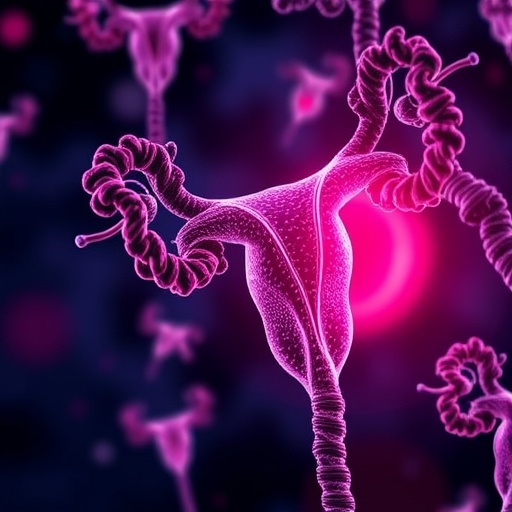
In a groundbreaking new study, researchers have unveiled novel insights into the environmental exposures faced by pregnant individuals residing near unconventional oil and gas extraction sites. Utilizing cutting-edge isotopic analysis techniques, the investigative team focused on strontium isotope ratios in urine samples to identify and trace sources of strontium exposure. This innovative approach not only sheds light on complex environmental pathways but also holds crucial implications for public health, particularly concerning fetal development and prenatal care in communities adjacent to unconventional oil and gas operations.
Strontium (Sr), a naturally occurring element found in soil, water, and biological systems, exists in several isotopic forms, with ^87Sr and ^86Sr being the most commonly analyzed for environmental tracing. The ratio of ^87Sr to ^86Sr can act as a distinctive fingerprint, allowing scientists to differentiate sources of exposure based on geological and industrial signatures. Past investigations into strontium isotopes have primarily focused on archaeological or geochemical studies, whereas this novel application prioritizes environmental health by scrutinizing internal dose markers in humans.
The research, conducted by Houessionon, Saar de Almeida, Widory, and colleagues, involved carefully collecting and analyzing urinary samples from pregnant individuals living in proximity to unconventional oil and gas wells. Unconventional wells, unlike traditional drilling operations, extract hydrocarbons from rock formations such as shale through hydraulic fracturing, or “fracking,” a process known to mobilize various naturally occurring elements into surrounding environments. Understanding whether such activities elevate internal exposure to potentially harmful substances in vulnerable populations has been a pressing scientific question.
.adsslot_81xlhpq4jE{width:728px !important;height:90px !important;}
@media(max-width:1199px){ .adsslot_81xlhpq4jE{width:468px !important;height:60px !important;}
}
@media(max-width:767px){ .adsslot_81xlhpq4jE{width:320px !important;height:50px !important;}
}
ADVERTISEMENT
Their methodological framework meticulously employed inductively coupled plasma mass spectrometry (ICP-MS) to measure the precise ratios of ^87Sr/^86Sr in urine, a novel biomonitoring strategy for environmental exposure assessment. This technique offered heightened sensitivity and specificity, enabling the differentiation of strontium sources derived from geological versus anthropogenic origins related to oil and gas operations. The interpretation of these isotopic signatures required integrating complex geochemical knowledge with human biological data—a synthesis rarely achieved in environmental epidemiology.
One of the pivotal findings of the study was the discernment of distinct strontium isotope ratios correlating with proximity to oil and gas wells. Pregnant individuals residing closer to these sites exhibited urinary ^87Sr/^86Sr ratios that deviated significantly from those in more distant populations, indicating increased exposure to strontium mobilized during unconventional extraction processes. This correlation emphasizes the penetrative reach of industrial activities into human biochemistry and underscores the subtle yet potentially hazardous environmental impacts on reproductive health.
The implications of strontium exposure during pregnancy are multifaceted. While strontium is not classified as a heavy metal with overt toxicity like lead or mercury, elevated intake has been linked in some studies to bone metabolism disruption and potential developmental effects. The transfer of strontium across the placental barrier illustrates the risk to the fetus during critical windows of growth. By revealing heightened internal exposures, the current research calls for a reassessment of environmental safety standards and regulatory oversight surrounding unconventional oil and gas extraction.
Beyond widened exposure insights, the study contributes to a growing body of evidence illustrating the utility of isotopic biomarkers in environmental health surveillance. The ability to non-invasively detect and source-track contaminants via urine analysis represents a methodological leap forward, particularly pertinent in monitoring vulnerable subpopulations such as pregnant individuals. It paves the way for precision public health approaches tailored toward minimizing exposures and mitigating adverse outcomes connected to evolving industrial landscapes.
Historical investigations in environmental exposure have largely depended on external environmental sampling or broad epidemiological correlations. The introduction of isotopic fingerprinting within biological matrices provides an enhanced resolution in the exposure-disease continuum. By establishing a biochemical linkage between nearby unconventional oil and gas operations and altered urinary strontium isotopic profiles, the study transcends traditional exposure assessments, bringing molecular insights into real-world human health impacts.
Moreover, this research intersects with broader concerns about the sustainability and societal costs of hydraulic fracturing and other unconventional hydrocarbon extraction methods. While these technologies have revolutionized energy markets by vastly expanding accessible reserves, their environmental footprints remain contentious. Documenting tangible internal exposures in sensitive groups such as pregnant populations adds a crucial dimension to ongoing debates regarding balancing energy development with environmental justice and health equity.
The findings encourage multidisciplinary collaborations, melding advanced geochemical methods with epidemiology and toxicology to form comprehensive exposure pathways models. They also spotlight the necessity to contextualize isotopic data within individual lifestyles, dietary sources, and background environmental distributions, ensuring interpretative accuracy and avoiding confounding. Future research trajectories may include longitudinal monitoring to track exposure trends over pregnancy and into early child development phases, addressing causality questions.
Public health agencies and policymakers stand to benefit from this nuanced evidence by refining exposure guidelines and health advisories in regions dominated by unconventional oil and gas activities. The insights serve as early warnings, advocating precautionary principles to shield sensitive demography segments, primarily when industrial expansions are planned near residential communities. Incorporating such biomonitoring techniques may become integral to environmental health surveillance frameworks worldwide.
Educational outreach stemming from this work could empower affected communities with knowledge about invisible exposures and pressures they face. Transparency concerning industrial emissions’ subtle permeation into human biology challenges conventional perceptions of pollution and prompts active community engagement in environmental decision-making processes. This paradigm shift might foster collaborative, informed advocacy designed to promote sustainable coexistence between industrial activity and public wellbeing.
Intriguingly, the study also opens possibilities for expanding the approach to other isotopic systems and contaminants beyond strontium, forging versatile platforms to uncover hidden environmental health burdens. Combining isotope ratio mass spectrometry with expanding -omics technologies could illuminate comprehensive exposome dimensions, refining risk assessment models for diverse populations. Such integrative strategies are instrumental to advancing precision environmental medicine in an era defined by complex anthropogenic influences.
By pioneering this intersectional examination of unconventional oil and gas operations, isotopic science, and prenatal health, the authors have set a precedent for future inquiries into subtle environmental risk factors traditionally overlooked. The research highlights essential avenues for improving environmental monitoring fidelity and deepening mechanistic understanding of exposure-related health risks. As unconventional energy landscapes continue evolving, such investigative rigor will remain vital to safeguarding society’s most vulnerable members.
This study exemplifies how sophisticated analytical science can transcend purely academic confines to guide actionable insights addressing pressing environmental health dilemmas. It reinforces the vital role that innovative biomonitoring techniques play in transforming raw chemical data into meaningful, targeted public health interventions. The intersection of strontium isotope geochemistry and epidemiology may now catalyze a new era where nuanced, biologically relevant environmental exposures are identified and mitigated with unprecedented precision.
Ultimately, the work of Houessionon and colleagues demonstrates that even seemingly minute chemical signatures can harbor significant stories about human-environment interactions, especially in contexts where industrial activity intersects intimately with daily life. Understanding these signatures at the molecular level provides a powerful lens to visualize and confront the invisible repercussions of modern energy extraction, embodying the future of environmental health research.
Subject of Research: Probing sources of strontium exposure in pregnant individuals living near unconventional oil and gas wells using urinary ^87Sr/^86Sr isotope ratios
Article Title: Probing sources of strontium exposure in pregnant individuals living near unconventional oil and gas wells using urinary ^87Sr/^86Sr isotope ratios
Article References:
Houessionon, K., Saar de Almeida, B., Widory, D. et al. Probing sources of strontium exposure in pregnant individuals living near unconventional oil and gas wells using urinary ^87Sr/^86Sr isotope ratios. J Expo Sci Environ Epidemiol (2025). https://doi.org/10.1038/s41370-025-00784-0
Image Credits: AI Generated
DOI: https://doi.org/10.1038/s41370-025-00784-0
Tags: environmental health and oil extractionexposure pathways in human healthfetal development and environmental factorsgeological signatures of strontiumhealth implications of oil well proximityinnovative research in environmental scienceisotopic analysis of urine samplesprenatal care and public healthsources of strontium in the environmentstrontium exposure in pregnant individualsstrontium isotope ratios and tracingunconventional oil and gas operations





